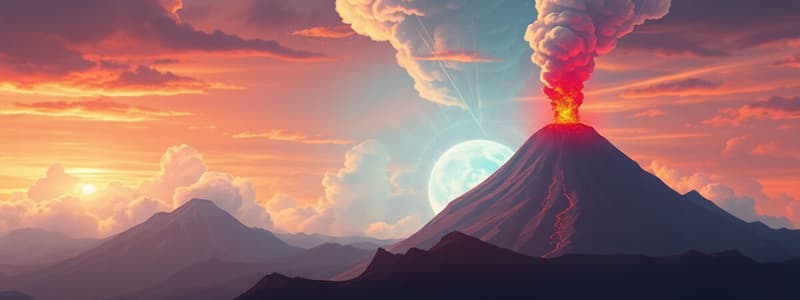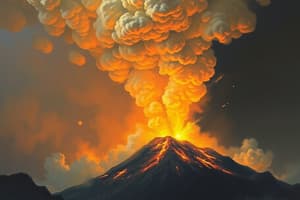Podcast
Questions and Answers
What is a lahara?
What is a lahara?
- Smooth and ropelike lava flows
- Lava that forms underwater
- Gaseous emissions from a volcano
- A flowing mixture of volcanic debris and water (correct)
Pahoehoe lava flows are rough and jagged.
Pahoehoe lava flows are rough and jagged.
False (B)
What are the lasting effects of volcanic emissions on the world?
What are the lasting effects of volcanic emissions on the world?
They can block out the sun, cause global cooling, poison the environment, and reshape the land.
_____ lava is characterized by its rounded, pillowy shape and forms underwater.
_____ lava is characterized by its rounded, pillowy shape and forms underwater.
Match the type of volcanic emission with its description:
Match the type of volcanic emission with its description:
Which gas makes up the largest percentage of volcanic emissions?
Which gas makes up the largest percentage of volcanic emissions?
All volcanic gases are harmless to the environment.
All volcanic gases are harmless to the environment.
What is the term for solid materials ejected from volcanoes during eruptions?
What is the term for solid materials ejected from volcanoes during eruptions?
Volcanic emissions can be classified into ______, solids, and liquids.
Volcanic emissions can be classified into ______, solids, and liquids.
Match the following volcanic emissions with their descriptions:
Match the following volcanic emissions with their descriptions:
What effect does Carbon Dioxide (CO2) have when released into the atmosphere?
What effect does Carbon Dioxide (CO2) have when released into the atmosphere?
What is the temperature range that molten rock (lava) can reach during volcanic eruptions?
What is the temperature range that molten rock (lava) can reach during volcanic eruptions?
Hydrogen sulfide (H2S) is known for its sweet smell.
Hydrogen sulfide (H2S) is known for its sweet smell.
Flashcards
Lahar
Lahar
A mixture of volcanic debris and water that flows rapidly downhill during volcanic eruptions.
Pahoehoe
Pahoehoe
Smooth, rope-like lava flows often formed by low viscosity basaltic lava.
Pillow Lava
Pillow Lava
Lava that cools and forms rounded, pillow-like shapes underwater.
Lasting Effects of Volcanic Emissions
Lasting Effects of Volcanic Emissions
Signup and view all the flashcards
Volcanic Emissions: A Double-Edged Sword
Volcanic Emissions: A Double-Edged Sword
Signup and view all the flashcards
What are volcanic emissions?
What are volcanic emissions?
Signup and view all the flashcards
How are volcanic emissions classified?
How are volcanic emissions classified?
Signup and view all the flashcards
What is the most abundant volcanic gas?
What is the most abundant volcanic gas?
Signup and view all the flashcards
What are the effects of Carbon Dioxide (CO2) emissions?
What are the effects of Carbon Dioxide (CO2) emissions?
Signup and view all the flashcards
What is the effect of Sulfur Dioxide (SO2) emissions?
What is the effect of Sulfur Dioxide (SO2) emissions?
Signup and view all the flashcards
What is volcanic ash?
What is volcanic ash?
Signup and view all the flashcards
What is lava?
What is lava?
Signup and view all the flashcards
What are volcanic solids?
What are volcanic solids?
Signup and view all the flashcards
Study Notes
Volcanic Emissions
- Volcanoes release chemicals and materials due to extreme pressure from gases and magma within.
- Volcanic emissions are composed of gases, solids, and liquids.
Types of Emissions
- Gases: Primarily water vapor (70-90% of emissions), responsible for clouds and rainfall. Carbon dioxide (a greenhouse gas) can cause global cooling and suffocation. Sulfur dioxide reacts with water to form sulfuric acid, leading to acid rain. Hydrogen sulfide has a distinctive "rotten egg" smell.
- Solids: Volcanic ash (fine particles of crushed rock and glass), lapilli (pebble-sized fragments), volcanic bombs (chunks of lava), and tephra fall (fragmented material).
- Liquids: Lava (molten rock), lahars (flowing mixtures of volcanic debris and water), pahoehoe (smooth, rope-like lava flows), and pillow lava (undersea lava with rounded shapes).
Lasting Effects
- Emissions have short-term and long-term impacts.
- Gaseous emissions can block sunlight, leading to global cooling.
- Solids damage infrastructure and ecosystems.
- Liquids can contaminate environments and cause poisoning.
- Though dangerous, volcanic emissions are also beneficial by reshaping landscapes, enriching soil, and being a natural Earth process.
Studying That Suits You
Use AI to generate personalized quizzes and flashcards to suit your learning preferences.




